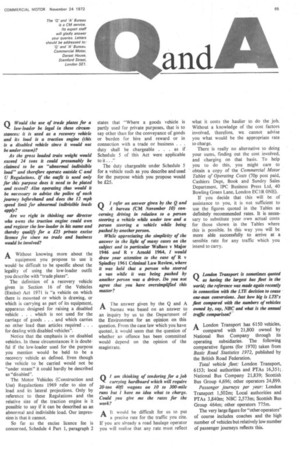Q Would the use of trade plates for a low-loader be
Page 61

If you've noticed an error in this article please click here to report it so we can fix it.
legal in these circumstances: it is used as a recovery vehicle and its load is a traction engine (this is a disabled vehicle since it would not be under .steam)?
As the gross loaded train weight would exceed 24 tons it could presumably be claimed to be an "abnormal indivisible load" and therefore operate outside C and U Regulations. If the outfit is used only for this purpose does it need to be plated and tested? Also operating thus would it be necessary to advise the police of each journey beforehand and does the 12 mph speed limit for abnormal indivisible loads apply?
Are we right in thinking our director who owns the traction engine could own and register the low-loader in his name and thereby qualify for a 125 private excise licence fee since no trade and business would be involved?
AWithout knowing more about the
equipment you propose to use it would be difficult to be specific about the legality of using the low-loader outfit you describe with "trade plates".
The definition of a recovery vehicle given in Section 16 of the Vehicles (Excise) Act 1971 is "a vehicle on which there is mounted or which is drawing, or which is carrying as part of its equipment, apparatus designed for raising a disabled vehicle . . . which is not used for the carriage of goods . . and which carries no other load than articles required . . for dealing with disabled vehicles".
Notice that the emphasis is on disabled vehicles. In these circumstances it is doubtful if the low-loader used for the purpose you mention would be held to be a recovery vehicle as defined. Even though the vehicle to be carried would not be "under steam" it could hardly be described as "disabled".
The Motor Vehicles (Construction and Use) Regulactions 1969 refer to size of load and its lateral projections. Only by reference to these Regulations and the relative size of the traction engine is it possible to say if it can be described as an abnormal and indivisible load. Our impression is that it cannot.
So far as the excise licence fee is concerned, Schedule 4 Part 1, paragraph 2 states that "Where a goods vehicle is partly used for private purposes, that is to say other than for the conveyance of goods or burden for hire and reward or in connection with a trade or business . . . duty shall be chargeable . . . as if Schedule 5 of this Act were applicable to it The duty chargeable under Schedule 5 for a vehicle such as you describe and used for the purpose which you propose would be £25.












































































































